Blower motor wiring diagrams
Blower motor wiring diagrams — two most common diagrams
A blower motor problem is easy to fix if you understand how your particular system is wired. Here are the blower motor fix steps:
To determine which blower motor wiring diagram, first determine if you have a manual or automatic heating system in your vehicle
Do you set the temperature and the system keeps that temperature or do you have to adjust the temperature up manually and then turn it down once the cabin heats up? If you set the temperature and the system takes care of the rest, you have automatic climate control. In that case, you usually have a variable speed fan.
If you have a manual system where you vary the temperature, you probably have a 3 or 4 speed fan. Why do you need to know that? Because most automatic systems use an electronic motor controller while manual systems usually use a blower motor resistors to obtain 3 or 4 different speeds.
What is a blower motor resistor?
Heating systems with just 3 or 4 speeds use a blower motor resistor along with the speed switch to regulate the motor speed. The resistors are arranged in series to reduce the voltage in steps, depending on where in the series you apply power.
Blower resistors can burn out. When that happens, you lose that speed. So you may have high speed, but no lower speeds.
What is a blower motor controller?
A variable speed motor is controlled by a digital speed controller. In most cases, the controller receives a digital input from the speed switch or HVAC control head. The control head then sends a command to the motor controller to change the speed to the driver’s preferences. To obtain the requested speed, the motor controller rapidly pulses the ground circuit on and off. So a half speed driver request will result in the blower motor controller pulsing the ground connection off twice as often as when the fan is running at full speed.
Blower motor wiring diagrams for three or four speed systems
Carmakers use these three common wiring methods to supply power and ground to the blower motor in a manual system using a blower motor resistor. In one design, the car maker supplies battery power to the speed switch, which switches the power to the appropriate connection on the blower motor resistor. In those applications, the motor resistor reduces power for the slower speeds and the blower motor has a permanent ground connection to complete the circuit. See the wiring diagram for that setup below.
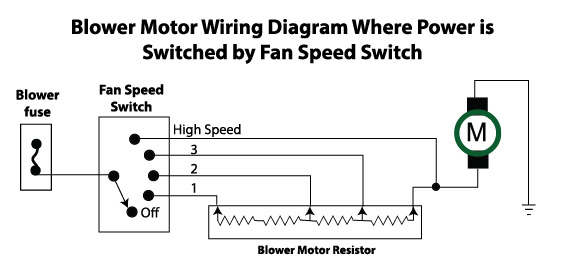
Or, carmakers can supply power to the motor and control blower speeds on the ground side of the circuit. See the wiring diagram for that setup below.
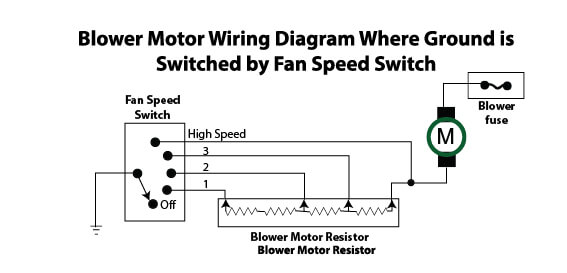
Or, carmakers can opt for a motor resistor AND a high speed relay. See the wiring diagram below for that setup.
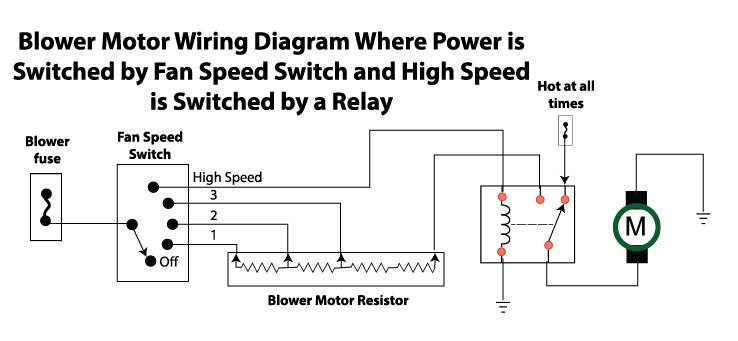
Blower motor wiring diagram for variable speed systems
Variable speed blower motors don’t use a blower motor resistor. Instead they use a blower motor speed control or a power transistor. Variable speed motors are 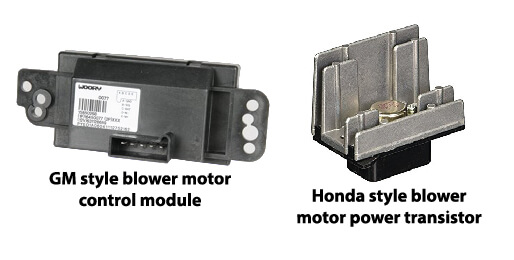 most often used in vehicles with automatic climate control. In those applications, the HVAC control head is a digitally controlled unit and uses various sensor inputs to determine when to supply heat. Based on the driver’s input to the blower speed switch, the HVAC control head sends a digital signal to the blower motor speed control module. The module uses that information to pulse either power or ground to the motor. See the wiring diagram below for a typical variable speed motor setup.
most often used in vehicles with automatic climate control. In those applications, the HVAC control head is a digitally controlled unit and uses various sensor inputs to determine when to supply heat. Based on the driver’s input to the blower speed switch, the HVAC control head sends a digital signal to the blower motor speed control module. The module uses that information to pulse either power or ground to the motor. See the wiring diagram below for a typical variable speed motor setup.
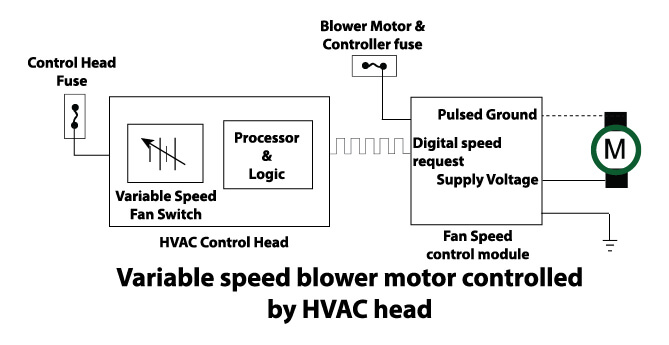
If your motor doesn’t work on any speed
In a situation where the motor doesn’t work on any speed, the most likely causes are: a blown power supply fuse, a bad motor ground connection, bad motor speed control module or a failed motor. On all systems, a failed blower motor is least likely. Blower motors generally don’t fail out of the clear blue. In most cases, they start to fail by making a high pitched squeal or screeching noise that indicates the bearing is failing. The squealing noise happens most often in the winter during cold startups and may disappear as the motor heats up. If you ignore the noise, the bearing will continue to wear to the point where the motor won’t start at all.
The reason I’m not including the motor resistor as a suspect is because it usually only controls the lower speeds. The highest blower speed usually bypasses the motor resistor completely, so it’s not a suspect if the motor doesn’t work at any speed.
Start by checking the blower fuse and HVAC controller fuse. If it’s good, refer to a wiring diagram for your vehicle and conduct these tests:
If you have a variable speed blower motor system:
Disconnect the electrical connector at the blower motor and jumper power and ground to the motor, bypassing all the speeds controls. Run a fused jumper from the battery to the power side of the motor and connect a temporary grounding jumper to the other motor terminal. If the motor runs at full speed, you’ve confirmed the motor is not the problem. At that point the suspects are the blower motor speed control module (most likely) or the HVAC control head (less likely, but not unheard of). Unfortunately, you’ll need a digital scope or scan tool to test those components, so your only option may be to replace the parts one at a time.
If power is supplied to blower motor through the speed switch and blower motor resistor:
Disconnect the electrical connector at the blower motor. Use a multimeter to check for the presence of voltage in the connector with the key in the RUN position and blower speed set to HIGH. You should see battery voltage (12+). If you see battery voltage in the connector, connect 1 meter lead to the power terminal in the connector and the other lead to the ground connector. If you get a good ground reading, the problem is most likely a bad motor. If you don’t see good ground, locate the ground connection and clean it. The plug the connector back into the motor and check operation. If it runs, you’ve solved the problem. If still doesn’t run, replace the motor.
If power is supplied directly to the blower motor and grounded through the speed switch
Disconnect the electrical connector at the blower motor. Use a multimeter to check for the presence of battery voltage in the connector with the key in the RUN position and blower speed set to HIGH. If you don’t see battery voltage, you’ve got a wiring or relay problem on the power supply side of the circuit.
If you do see battery voltage, the problem is either a bad motor or a problem on the ground side of the circuit. Run a fused jumper from the battery to the power side of the motor and connect a temporary grounding jumper to the other motor terminal. The motor should run on high speed. If it doesn’t, the motor is bad. If the motor runs, locate the ground connection and clean it. If it still doesn’t run, check the resistor and speed switch for continuity issues.
Blower only works on high speed
This is a dead ringer symptom of a bad blower motor resistor, 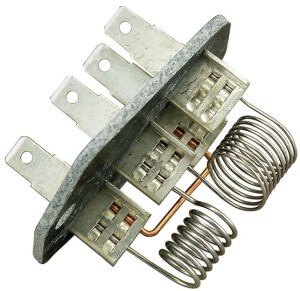 not a bad speed switch. Replace the resistor.
not a bad speed switch. Replace the resistor.
Blower works on slow speeds, but not on high speed
Check for bad fuse or bad high speed relay. Swap the high speed relay with another relay with the same part number. 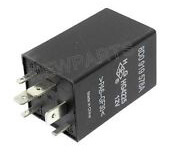 Also, check the fuse for the control side of the high speed relay. Make sure the ground side of the high speed relay is working.
Also, check the fuse for the control side of the high speed relay. Make sure the ground side of the high speed relay is working.
Blower works on some speeds but not others
This can be a bad blower motor resistor or a failed speed switch. Refer to the wiring diagram for your vehicle and check for continuity on all three resistors and speed switch setttings.
Blower motor resistor has repeat failures
Check for full airflow at the vents. If airflow seems restricted or lower than normal, 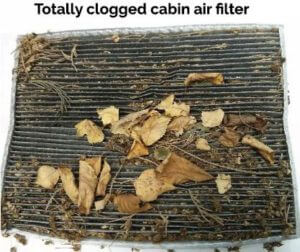 check the cabin air filter. If it’s good, check for debris on the evaporator or heater. Decreased airflow causes the blower motor resistor to overheat and fail. Reduced airflow also causes the blower motor to work harder, draw more current and that can cause repeat blower motor resistor failures.
check the cabin air filter. If it’s good, check for debris on the evaporator or heater. Decreased airflow causes the blower motor resistor to overheat and fail. Reduced airflow also causes the blower motor to work harder, draw more current and that can cause repeat blower motor resistor failures.
Blower motor fuse blows repeatedly
Blower motor is drawing too much power. Check the cabin air filter for clogging. Check for airflow restrictions in the duct, paying attention to debris on the evaporator or heater core.
Melted connector at blower motor
See blower motor fuse blows repeatedly. 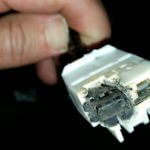
Blower motor squeals or screeches at startup
This is a symptom of a failing blower motor bearing. The bearing is not replaceable. Replace the blower motor.
Blower motor doesn’t work in cold weather
Bad bearing in blower motor. Replace blower motor.
Blower motor doesn’t shut off
If you have a variable speed blower motor, replace the 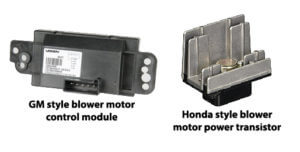 blower motor speed control module. If you have a three or four speed blower motor, remove the blower motor relay. If the motor stops, replace the relay.
blower motor speed control module. If you have a three or four speed blower motor, remove the blower motor relay. If the motor stops, replace the relay.
©, 2017 Rick Muscoplat
Posted on by Rick Muscoplat